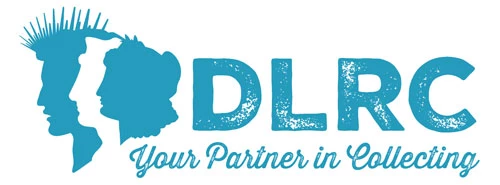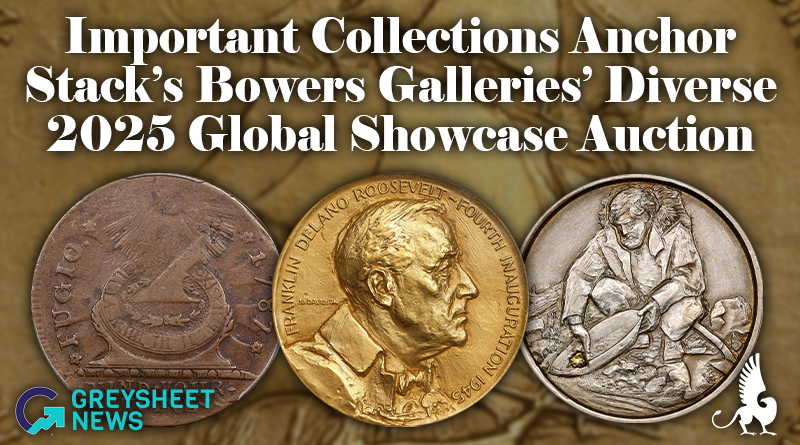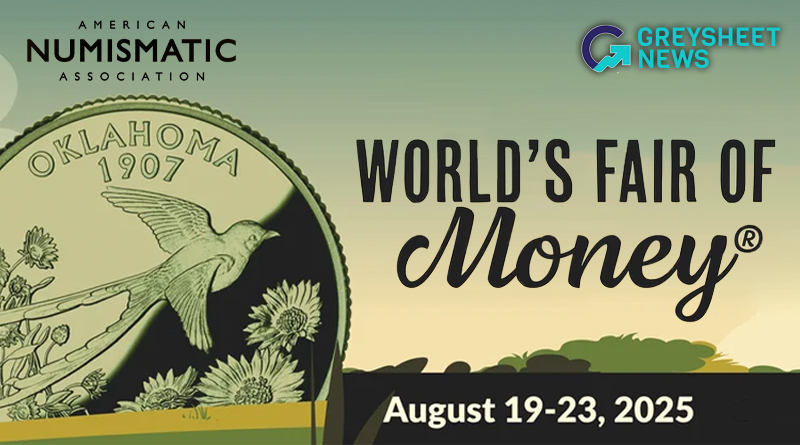Greysheet & CPG® PRICE GUIDE
- U.S. Coins /
- Pattern Coinage /
-
Patterns (1849) Values
Year
Sort by
About This Series
History and Overview
In 1849, James B. Longacre, chief engraver since 1844, produced a variety of interesting and numismatically important patterns, today the most remembered being the famous double eagle of that year.
Consideration was given to making a three-cent piece in silver, a new addition to the coinage lineup, representing a value above the cent and below the half dime. The coinage of pattern cents of a new format would wait until 1850, but pattern three-cent coins were made posthaste in 1849, with examples ready by January 18.
In the rush to test a silver three-cent piece, or trime (as it was later referred to in Treasury documents), in 1849, a regular half dime obverse die was combined with two hastily created reverses: one simply with the numeral 3 and the other with the same value expressed as III.
Impressions of the three-cent piece were made in different alloys, one with 50% silver and 50% copper and another with 60% silver and 40% copper. Restrikes were produced at a later date, probably beginning in 1859, from normal silver planchet stock used for circulating coinage at that time (90% silver and 10% copper). Today, elemental analysis would be needed to differentiate the coinage metals to assure proper attribution.
In 1849, large quantities of gold from the California fields reached the East. Gold became “common” in comparison to silver, and the historic ratio of value between the two metals changed. The price of silver bullion rose on the international market, and by 1850, it took more silver to produce a half dime, dime, quarter dollar, half dollar, or silver dollar, than the face value of such coins. Eventually, a silver three-cent piece of reduced silver content was made for general circulation in 1851, by which time almost all regular silver coins had been removed from circulation by hoarders and speculators. The regular-issue silver three-cent piece was of a different alloy, 25% copper and 75% silver (instead of 90% silver), thus making them unprofitable to melt down. However, the pattern silver three-cent pieces of 1849 are of a different status, and the rising value of silver was not considered during their preparation, nor had hoarding of silver coins become widespread.
The influx of vast quantities of gold in 1849 prompted consideration for two new denominations, the $1 and $20. The gold dollar, made in pattern form at the Mint in 1836 and, of a different design, privately by Christopher Bechtler in North Carolina earlier, again became important. The prospect of coining a federal gold dollar had arisen again in 1844, and some patterns were restruck from 1836-dated dies, but no production for circulation materialized.
In 1849, Chief Engraver Longacre produced several examples of hand-engraved gold dollars. These had a square opening at the center, in the manner of Oriental coins, so that an appropriate weight of gold could be used in a coin larger in diameter than would otherwise be the case. These pieces, not struck from dies, can be considered numismatic folk art in a way, as they are directly from the hand of Longacre. Examples exist in gold and also gold-plated silver.21 However, numismatists enumerate them as coins, again proving that among patterns, most rules have exceptions.
The centerpiece pattern of 1849 is the double eagle, the largest regular denomination in American coinage. Authorized by the Act of March 3, 1849, as was the gold dollar, the double eagle was twice the size of the eagle or $10 piece, thus giving rise to its name. Longacre set to work on this and the gold dollar, both of which would be the first entries of a specific new design created by his hand. The same motif was used for both, a distinctive head of Liberty, facing left, with LIBERTY on a coronet, stars around, no date on the gold dollar but the date 1849 on the double eagle. No struck gold-dollar patterns are known; no doubt some were made.
Longacre began first on the reverse of the double eagle, creating a distinct motif with a heraldic eagle loosely adapted from the Great Seal, but with the sides of the shield on the eagle’s breast being parallel, and the wings treated differently. The left and right were ornamental bands, giving an overall bulbous shape to the center motif. Above the eagle’s head was an ellipse of 13 stars and resplendent rays. The inscription UNITED STATES OF AMERICA / TWENTY D was around the border.
The obverse of the double eagle presented problems, as the relief was too high to fully strike up the details in a regular coining press. However, the proper relief was finally accomplished, and double eagles, first struck for circulation in 1850, were a resounding success. In the meantime, several patterns were struck in gold with an 1849 date. Just one is known to exist today, perhaps the most famous of all rarities held in the National Numismatic Collection in the Smithsonian Institution.22
Collecting Perspective
Today the pattern three-cent pieces of 1849 are highly collectible, and the three different die combinations can be acquired without great difficulty, although they are hardly common.
Engraved patterns for the gold dollar, in gold and in gold-plated silver, are very rare and appear on the market at only widely spaced intervals. Regarding the 1849 pattern double eagle, the unique piece rests in the Smithsonian Institution. There is a gilt brass example, believed to be a restrike, which made its debut in the 1870s23 but it has not been located today.
Catalog Detail
Legal Disclaimer
The prices listed in our database are intended to be used as an indication only. Users are strongly encouraged to seek multiple sources of pricing before making a final determination of value. CDN Publishing is not responsible for typographical or database-related errors. Your use of this site indicates full acceptance of these terms.


















| Patterns (1849) | Value Range | Favorite | |||
|---|---|---|---|---|---|
| Patterns (1849) | Value Range | ||||
|
$10,000
-
$53,000
$10,000 - $53,000
|
||||
|
-
|
||||
|
$8,250
-
$21,500
$8,250 - $21,500
|
||||
|
-
|
||||
|
$31,000
-
$37,500
$31,000 - $37,500
|
||||
|
-
|
||||
|
$14,500
-
$21,500
$14,500 - $21,500
|
||||
|
$72,000
-
$129,500
$72,000 - $129,500
|
||||
|
$54,000
-
$60,000
$54,000 - $60,000
|
||||
|
-
|
||||
|
-
|
||||
From the Greysheet Marketplace
Buy Now: $6,891.25
Buy Now: $38,900.00
Buy Now: $31,500.00
Buy Now: $37,000.00
Buy Now: $2,890.63
Buy Now: $125,000.00
Buy Now: $120,000.00
Buy Now: $3,600.00
Buy Now: $5,500.00
Buy Now: $3,695.00
Related Stories (powered by Greysheet News)
View all news
Greysheet Catalog Details
History and Overview
In 1849, James B. Longacre, chief engraver since 1844, produced a variety of interesting and numismatically important patterns, today the most remembered being the famous double eagle of that year.
Consideration was given to making a three-cent piece in silver, a new addition to the coinage lineup, representing a value above the cent and below the half dime. The coinage of pattern cents of a new format would wait until 1850, but pattern three-cent coins were made posthaste in 1849, with examples ready by January 18.
In the rush to test a silver three-cent piece, or trime (as it was later referred to in Treasury documents), in 1849, a regular half dime obverse die was combined with two hastily created reverses: one simply with the numeral 3 and the other with the same value expressed as III.
Impressions of the three-cent piece were made in different alloys, one with 50% silver and 50% copper and another with 60% silver and 40% copper. Restrikes were produced at a later date, probably beginning in 1859, from normal silver planchet stock used for circulating coinage at that time (90% silver and 10% copper). Today, elemental analysis would be needed to differentiate the coinage metals to assure proper attribution.
In 1849, large quantities of gold from the California fields reached the East. Gold became “common” in comparison to silver, and the historic ratio of value between the two metals changed. The price of silver bullion rose on the international market, and by 1850, it took more silver to produce a half dime, dime, quarter dollar, half dollar, or silver dollar, than the face value of such coins. Eventually, a silver three-cent piece of reduced silver content was made for general circulation in 1851, by which time almost all regular silver coins had been removed from circulation by hoarders and speculators. The regular-issue silver three-cent piece was of a different alloy, 25% copper and 75% silver (instead of 90% silver), thus making them unprofitable to melt down. However, the pattern silver three-cent pieces of 1849 are of a different status, and the rising value of silver was not considered during their preparation, nor had hoarding of silver coins become widespread.
The influx of vast quantities of gold in 1849 prompted consideration for two new denominations, the $1 and $20. The gold dollar, made in pattern form at the Mint in 1836 and, of a different design, privately by Christopher Bechtler in North Carolina earlier, again became important. The prospect of coining a federal gold dollar had arisen again in 1844, and some patterns were restruck from 1836-dated dies, but no production for circulation materialized.
In 1849, Chief Engraver Longacre produced several examples of hand-engraved gold dollars. These had a square opening at the center, in the manner of Oriental coins, so that an appropriate weight of gold could be used in a coin larger in diameter than would otherwise be the case. These pieces, not struck from dies, can be considered numismatic folk art in a way, as they are directly from the hand of Longacre. Examples exist in gold and also gold-plated silver.21 However, numismatists enumerate them as coins, again proving that among patterns, most rules have exceptions.
The centerpiece pattern of 1849 is the double eagle, the largest regular denomination in American coinage. Authorized by the Act of March 3, 1849, as was the gold dollar, the double eagle was twice the size of the eagle or $10 piece, thus giving rise to its name. Longacre set to work on this and the gold dollar, both of which would be the first entries of a specific new design created by his hand. The same motif was used for both, a distinctive head of Liberty, facing left, with LIBERTY on a coronet, stars around, no date on the gold dollar but the date 1849 on the double eagle. No struck gold-dollar patterns are known; no doubt some were made.
Longacre began first on the reverse of the double eagle, creating a distinct motif with a heraldic eagle loosely adapted from the Great Seal, but with the sides of the shield on the eagle’s breast being parallel, and the wings treated differently. The left and right were ornamental bands, giving an overall bulbous shape to the center motif. Above the eagle’s head was an ellipse of 13 stars and resplendent rays. The inscription UNITED STATES OF AMERICA / TWENTY D was around the border.
The obverse of the double eagle presented problems, as the relief was too high to fully strike up the details in a regular coining press. However, the proper relief was finally accomplished, and double eagles, first struck for circulation in 1850, were a resounding success. In the meantime, several patterns were struck in gold with an 1849 date. Just one is known to exist today, perhaps the most famous of all rarities held in the National Numismatic Collection in the Smithsonian Institution.22
Collecting Perspective
Today the pattern three-cent pieces of 1849 are highly collectible, and the three different die combinations can be acquired without great difficulty, although they are hardly common.
Engraved patterns for the gold dollar, in gold and in gold-plated silver, are very rare and appear on the market at only widely spaced intervals. Regarding the 1849 pattern double eagle, the unique piece rests in the Smithsonian Institution. There is a gilt brass example, believed to be a restrike, which made its debut in the 1870s23 but it has not been located today.
Catalog Detail
Legal Disclaimer
The prices listed in our database are intended to be used as an indication only. Users are strongly encouraged to seek multiple sources of pricing before making a final determination of value. CDN Publishing is not responsible for typographical or database-related errors. Your use of this site indicates full acceptance of these terms.










 Loading more ...
Loading more ...










